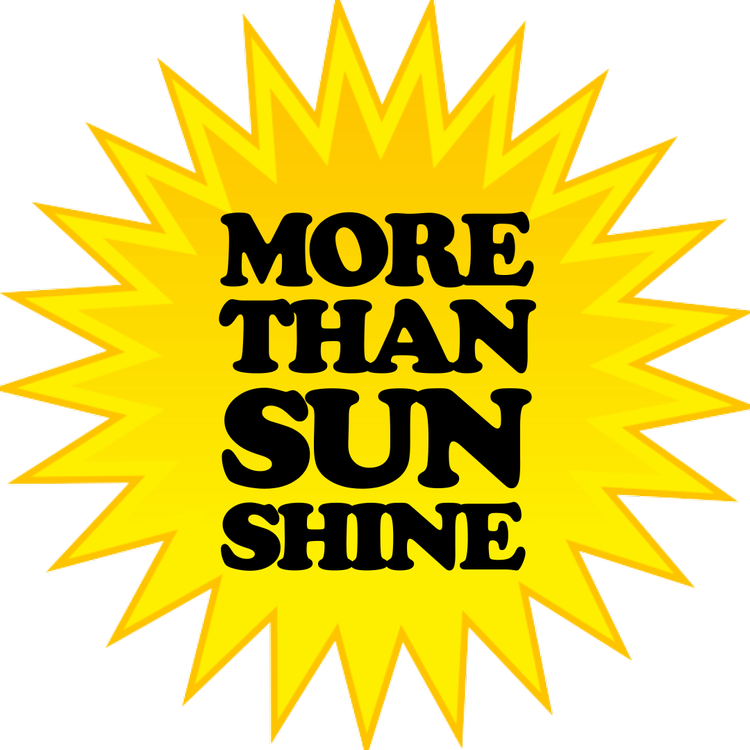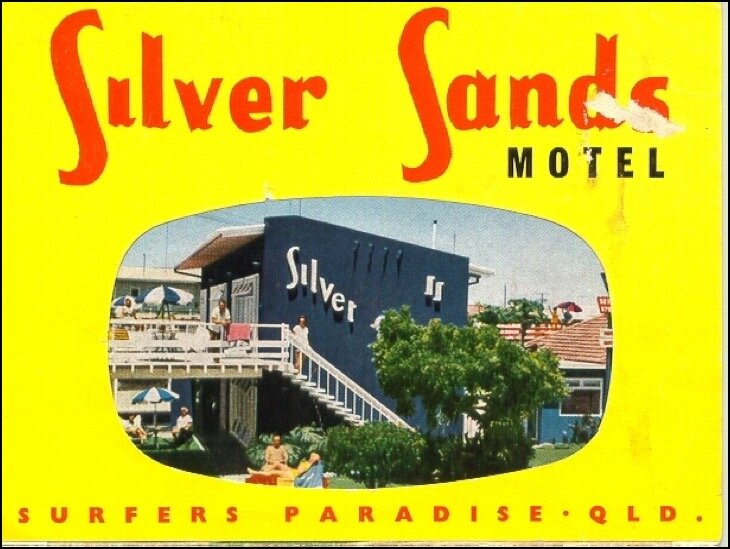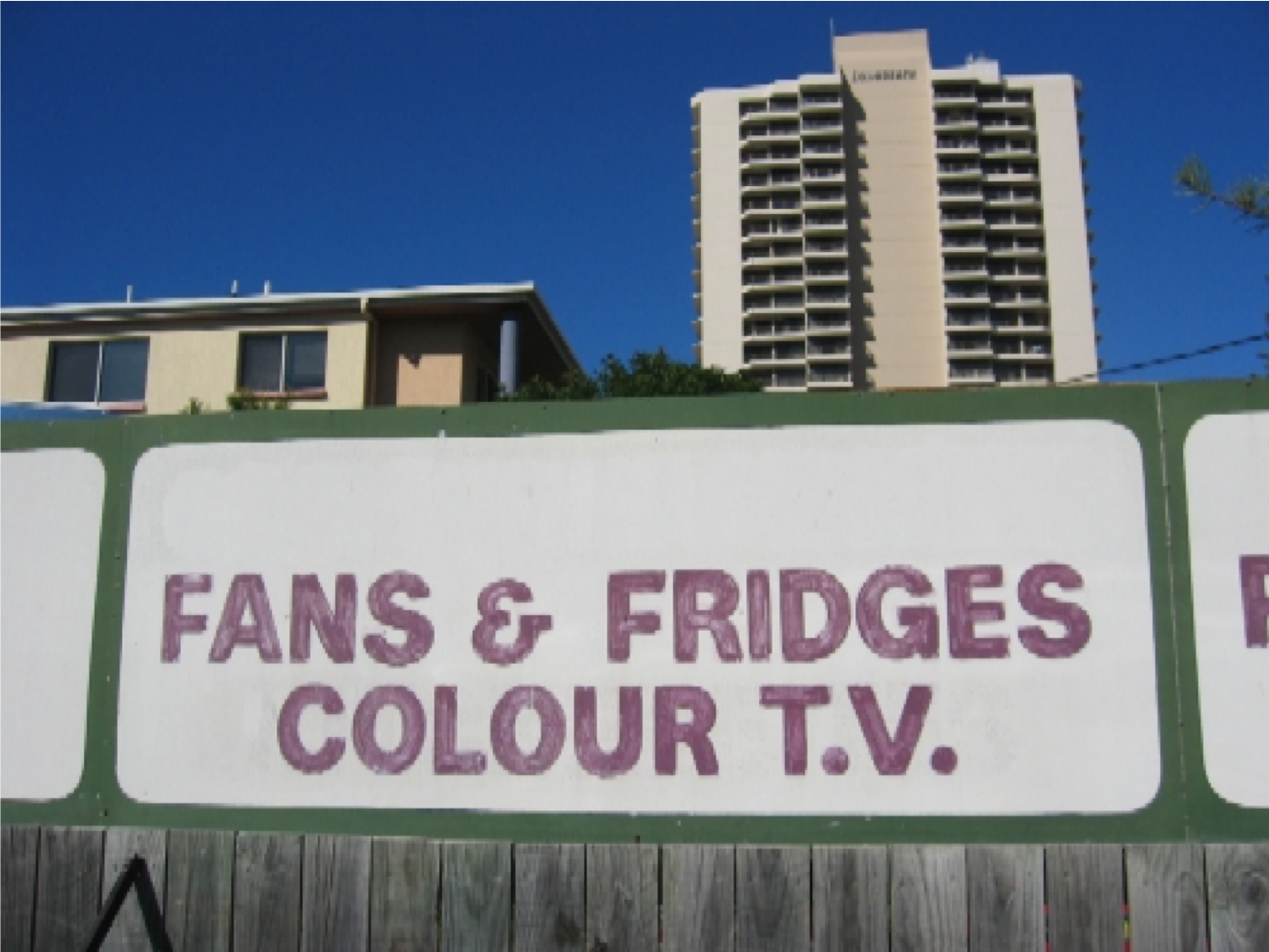Motels have been a significant feature of the Gold Coast since they emerged in the 1950s. They were a popular and prominent tourist accommodation option for around 30 years, but since the 1990s, the number of motels has been declining to the point where it now seems like this aspect of our urban heritage will vanish altogether in the next decade. This story is a tribute to our early moteliers, the motels we loved and lost, and the few survivors.
THE CRUISES
Twenty years ago, in partnership with the local branch of National Trust of Queensland, I produced an exhibition and event to celebrate the places and people associated with Gold Coast Motels. We held it in the Evandale Council foyer and called it Highway Heritage.
Paddy, Kathryn and Jo Cruise at the Highway Heritage exhibition launch, 1999
The richest reward from my extensive efforts to pull that together was a friendship that I established with Paddy and Jo Cruise. They lived in Southport and I visited them regularly for sandwiches and stories. Paddy was 91 at the time, and Jo was a couple of years younger.
Paddy was an Irishman who had met Greg Graham during WW2. After the War, Paddy decided to migrate to Australia, and he began helping out the Graham family who ran a holiday guesthouse in Lakes Entrance in Victoria.
Mr Graham, ventured to Surfers Paradise in the early 1950s where he built and operated the El Dorado which may have been our very first motel. That stood where today we have the QT Hotel.
El Dorado Motel, Surfers Paradise
Paddy and his new wife Jo followed the Grahams and moved to Surfers Paradise where they managed The Californian Motel in Laycock Street.
The Californian, Laycock Street, Surfers Paradise
After that they operated the Silver Sands Motel for many years and later the Candlelight Motel off Whelan Street. Jo ran that one on her own, because by then, Paddy had become an executive with the huge Quality Inns Hotel business that Greg Graham established in the 1970s with highrise accommodation including The Iluka, The Chateau, Apollo and The Islander.
Silver Sands Motel, Surfers Paradise
Candlelight Motel, Whelan Street, Surfers Paradise
Paddy and Jo told many wonderful stories about motels and their friends in the business. They spoke of it as a golden era, not without some low times and business rivalry, but certainly it had a sense of buoyancy and hospitality.
THE FIRST MOTELS
Davidson and Spearritt in their book ‘Holiday Business’ tell how Melbourne Architect Leslie Perrot in Walkabout Magazine 1952 advocated the erection of American-style motor courts or motels to address the deficiency of facilities available for the growing motoring public.
Moomba Motel
It is debatable to nominate which was the first motel in Australia because at the same time as new purpose-built flats began appearing, older holiday apartments too, were upgrading by installing cooking and bathing facilities and calling themselves motels.
Davidson and Spearritt suggest that the first motels opened in Orange, Wagga Wagga and Surfers Paradise in 1955. I collect old tourist books about the Gold Coast and several actually record Greg Graham’s El Dorado being built in 1954 which could mean that it was the first. Another Gold Coast publication claims that Surf Riders Motel at Main Beach was the first motel at the Coast.
El Dorado Motel, Surfers Paradise (photo by George Barnes)
Surf Riders Motel, Main Beach (photo by George Barnes)
Certainly, by 1960, this major new form of accommodation had planted itself on the Australian landscape. Queensland emerged as the motel capital of Australia with 59 motels, of which 36 were located at the Gold Coast. And ay the end of that decade, the Gold Coast Bulletin reported that:
“MOTELS MUSHROOM ON THE COAST: The Gold Coast – the biggest motel area in Queensland – has 119 of the State’s 511 motels... Indirectly, the State Government had promoted tourist growth by constructing 6000 additional miles of bitumen sealed roads, improving passenger rail services by dieselisation and introduction of air-conditioned carriages, constructed 13 boat harbours and 110 boat ramps and trebled the area of national parks and scenic reserves.”
All but a handful of those motels were situated along the Gold Coast Highway from Labrador to Coolangatta. I estimate that the number of motels would have peaked at around 140 in the late 1970s. My 1999 Highway Heritage survey to document the history recorded 85 survivors. I would be surprised if as many as 30 remain today.
THE CHARACTERISTICS OF MOTELS
The original motels were small establishments of often no more than a dozen rooms, owned and operated by husband and wife teams. The buildings were basic in construction, typically asbestos cement cladding with flat roofs. Usually a dominant building with reception and living quarters for the owner/operators faced the highway and a linear or L-shaped block of motel units extended from that with car spaces adjacent to the units. Exuberance of style was focused at the front with exotic gardens, rock walls and often fun or fantasy decorative themes. Every motel had illuminated highway signs to attract passing motorists. Motel guides were published to help families choose which motel they wanted to stay in. Moteliers added features to enhance their appeal. Features like pools, barbeques and games parlours and rooms with television and refrigerators all added to the desirability. In-room breakfasts were a novelty, ordered the night before and served on trays via a hatch next to the door. And we must not forget the chenille bedspreads, fanned towels and mini soaps. Some motels even had small in-house restaurants.
THE FUTURE OF MOTELS
Today, motel accommodation is dwindling. Some motel buildings are rented as low-cost residential units to permanent tenants. Some stand unoccupied.
La Costa Motel, Bilinga circa 1998
Several motels have been refurbished and now trade on a retro accommodation vibe. Business at La Costa Motel at Bilinga is going gangbusters. The Ocean View Motel at Coolangatta was renovated and renamed The Pink Hotel in 2018. Mermaid Park Flats Motor Inn has recently been painted and renamed the Ventura Beach Motel this site also advertises Development Approval for a highrise tower, which is really like a pending death sentence. Development potential allowed by the City Plan on land along the highway trumps any nostalgic resistance to protect motels for their heritage value. It seems unlikely that any motels will survive the next 20 years.
In 1999, I flagged an urgent need to record the stories of motel pioneers but in 2000, work and life took me in a different direction. I moved to Brisbane for more than a decade and never found time to look back. And now I regret I didn’t pursue the opportunity to gather motel stories from more people like Paddy and Jo Cruise. Most, if not all of their colleagues in the motel business have departed this world.
What we are left with today, is a small sample of remnant motels, photographs, postcards and some recorded memories. There are contemporary artworks by artists including Anna Carey, Luke Roberts, Tracey Cooper and the late Dean Cogle who have each considered motels from different perspectives. And of course we have the 1995 novel by Matthew Condon ‘A Night at the Pink Poodle’.
If I win the lotto soon, I will buy three or four of the most distinctive remaining motels and refurbish them to continue operating as Highway Heritage Motels.
In the meantime, I have started an Instagram account called Gold Coast Motels - like a digital museum where I can share my images, to prompt stories and keep alive some memories of our ‘highway heritage.’ I have an archive of photographs that I took in 1999 and since, plus a collection of vintage postcards that I will post as time permits. So, please watch this space Highway Heritage @goldcoastmotels, and add stories and information in the comments to enrich the historical record for everyone to see.








































